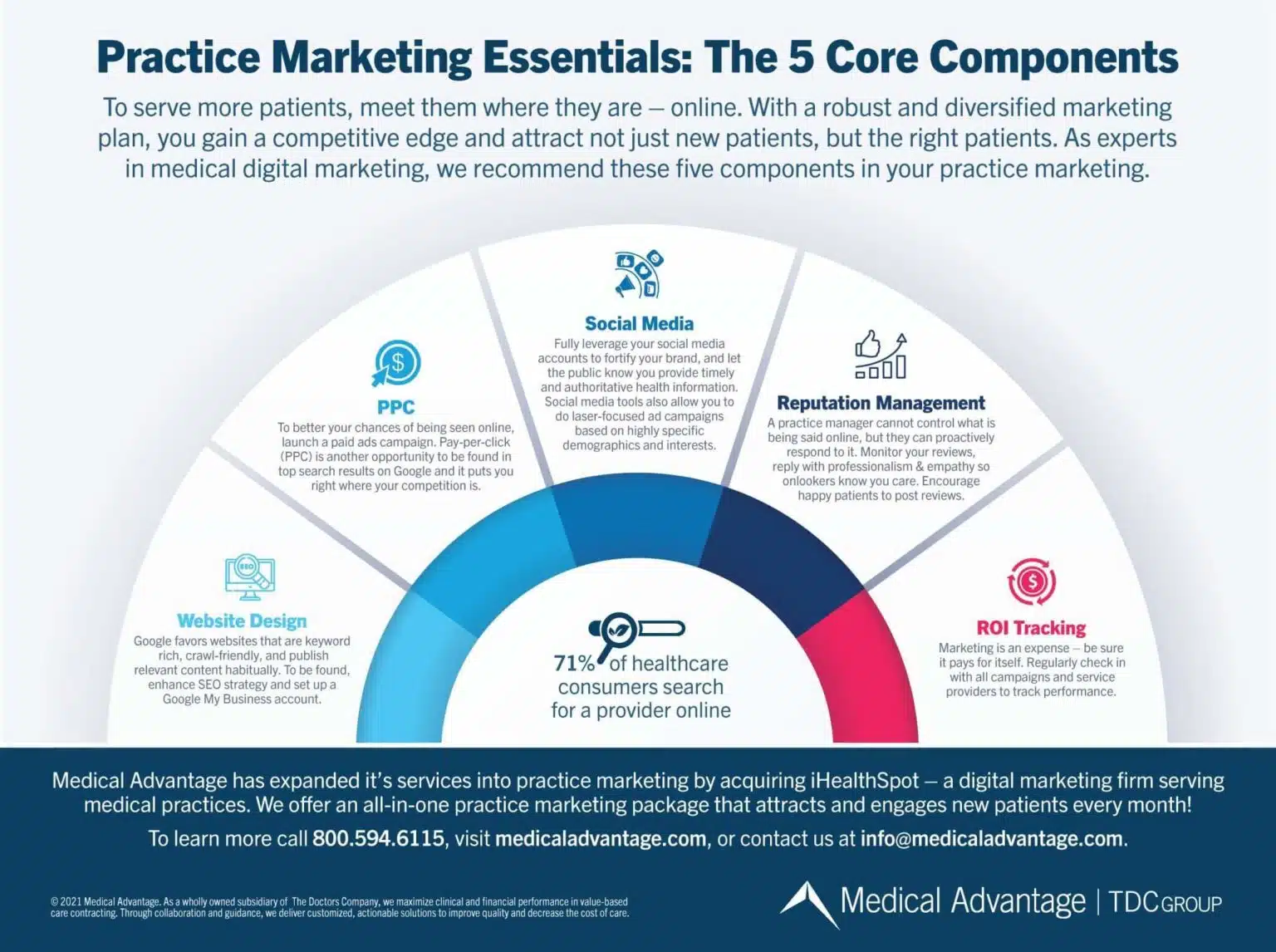
With patient care at the center of your practice, you may not think very much about marketing. However, for those new practices looking to have a strong launch, or established ones itching to increase patient volume, creating a solid medical digital marketing plan is essential to reaching these goals.
Why Your Medical Practice Needs a Digital Marketing Plan
Thanks to technology – especially mobile devices – patients look for a doctor the same way they would for any product or service. This search begins online, whereas in the past they would ask other resources for a referral, such as an insurance provider, or friends and family members.
If you did a test search on Google of a medical practice like yours, what would you see? Certain phrases trigger a localized search featuring listings for local providers. If you see your competition in this search rather than your own practice, it isn’t an accident that they appear front and center. Digital marketing increases the chances that prospective patients will find you online.
The more crowded your market is, the more you need marketing to differentiate your practice from the rest. But there are many different tools to get you there, and throwing your whole budget toward one method can easily backfire. Digital marketing strategy is about planning carefully, so you can invest wisely.
Traditional Vs. Digital Marketing
Traditional advertising, like direct mail, blankets a large region, whereas digital marketing campaigns can target a more precise audience by specific attributes. Rather than end up discarded with other mailers, digital marketing will put your advertising where people go when they are most motivated to find a new provider – online.
Another key difference between print advertising and digital advertising is the cost structure. When you pay for a print ad, the cost is based on the assumed size of the target market. With pay-per-click (PPC) like Google Ads, you only pay when someone interested clicks on the ad. For this reason, digital advertising is both the greener and the more cost-effective option.
Essential Elements of Any Marketing Strategy in Healthcare
Practice marketing consists of all those methods you deploy to connect with a potential patient. As mentioned earlier, there are several ways to promote your practice online. Core elements of an effective medical digital marketing strategy include:
- An interactive website optimized to capture new patient appointment requests
- Website optimized for search engine optimization (SEO) and continuous blog publication
- Google Ads (PPC) and Facebook ads to get in front of your ideal prospects
- Social media management to build relationships with the public and patients while you nurture your brand
- Online reviews management to promote consumer confidence in choosing your practice over others
- Online listings management to be found in as many places as possible
Ideally, all these elements should be activated, but depending on certain variables, some channels may be more critical than others. For example, a brand-new practice without much of an online presence would greatly benefit from a PPC campaign that can rank faster in search compared to organic means (SEO). But all medical practices should have a well-built website as it is the most important digital marketing asset.
Medical Practice Marketing Essentials Infographic from Medical Advantage
Building Your Healthcare Marketing Plan to Attract Potential Patients
Identifying who your target audience is and how to connect with them is the key to cost-effective digital marketing. Getting in front of your target audience not only makes advertising spend more efficient, it also increases the chances that the leads coming in are the right fit for your services.
Digital advertising platforms like Facebook can get very granular with audiences. Attributes like demographics and interests can be used to customize the ad experience for users. For example, a pediatric practice running a sports physical promotion could target parents of teenagers who show interest in high school football and equipment purchases.
Our Medical Practice Marketing Plan Template: A Closer Look at the 6 Key Tools
As mentioned earlier, practice marketing essentials include a user-friendly website, SEO, Google Ads, Facebook ads, active social media, online listings coverage, and online reviews management. Having all these channels activated in your medical practice marketing plan maximizes your online exposure so potential patients can find you online.
1.) A Website Turns Site Visitors into New Patients
Have a website that aids the patient journey. Give the visitor all the information they need to take the next step, including submitting a new patient appointment request.
A modern healthcare website design should be mobile-friendly. Responsive design now allows patients to navigate your website on a mobile device as easily as they would on a computer. Features like click-to-call make it easy for patients to contact you directly from your website.
The more complex your area of medicine, the more questions patients will have. The better information you can provide on your website in ways that help patients understand, the more positive a patient’s experience will be. This leaves your prospect with a great first impression.
Finally, your site should make it easy to become a new patient. Having the new patient request form on the main page rather than buried somewhere in a “Contact Us” section of the site turns a site visitor into a patient within minutes.
2.) Search Engine Optimization: Let New Patients Come to You
Have a website that Google deems valuable and relevant to users so this search engine will pick yours up in search results.
Integrating SEO best practices can turn a beautiful, well-functioning website into one that appears in Google search results for high-value search terms – that your prospective patients are searching for online. It should be easy for Google to scan your website for information they can put in search results.
Keyword-rich content on your site informs Google’s algorithms as to who your site is relevant to. The content of the website needs to include keywords that match the search intent of your audience. To maintain SEO strength, regular blog content must be published.
3.) Paid Advertising on Google, Facebook, and More
Rule of thumb – if your competitors are running paid ads on high traffic platforms like Google and Facebook, it is in your best interest to do so as well.
PPC marketing, like Google Ads, gives you the option of paying to get to the top of search results. PPC campaigns get priority placement on the search engine results page (SERP), and this is the incentive to go this route. The upside of Google Ads is that you only pay for the clicks you generate. The downside is that this can add up quickly, so you should carefully budget to avoid surprise overspending.
PPC and SEO are often compared to one another as they are both the primary methods to being seen in search. The main difference is – with PPC your top search visibility ends the moment you stop paying but earned organic gains in search (SEO) last longer.
4.) Online Directory Listings
Claim your Google Business Profile and ensure all listings are accurate and up to date.
There is yet another way to be found in Google search, and it is very simple compared to SEO and PPC. As mentioned earlier, certain keywords trigger local search results for nearby businesses. Google’s listings prominently display in localized search. You can set up a free Google Business Profile for your medical practice.
In addition to Google’s listings, general healthcare provider listings sites like Healthgrades, WebMD and Vitals should also be optimized. This means you check the listings to ensure that it gives the correct information about your practice, such as address, operating hours, and all your locations. Specialists may be listed on niche directory sites as well, so it is wise to seek those out. Having consistent information on your listings provides a better patient experience and is also good for SEO
5.) Social Media: Why You Should be on Facebook, Twitter, and More
Social media for medical practices is a dynamic digital marketing tool because of how it builds connection with the local community and nurtures your brand. It allows you to connect with your patients outside of office visits, so it encourages patient loyalty.
It also captures patient satisfaction that will, in turn, convince prospective patients to book with your practice. Having a solid following, helpful social media content, and positive engagement signals to consumers that you provide an excellent patient experience.
6.) Reviews Management: Maximize Your Practice’s Online Reputation
Patient feedback about your practice is extremely powerful as it is more than likely to influence a patient’s decision to book with your practice. Your online reputation is a precious asset and worth paying attention to.
Word of mouth has been a reliable source of referrals for many decades. Online ratings and reviews are like word of mouth, but on a larger scale. On demand, patients can view feedback from dozens of current patients. In fact, close to 90 percent of patients refer to reviews before booking that initial appointment.
Getting the star rating you want takes some effort. The more positive reviews accrued, the higher your star-rating will be. Asking for reviews consistently helps build up your online profile and star rating. Reputation management for doctors will make your practice more attractive alongside the competition.
As your Google Business Profile ratings and reviews improve, so do your chances of showing up as one of the top three businesses in Google search. Only three businesses are initially displayed in search results, and securing one of those spots is golden.
Bringing These 6 Elements Together to Increase Your Practice’s Visibility
A complete medical practice marketing plan engages all marketing channels to maximize the chances of your ideal patients finding you online. To many patients, if a local establishment is not online, it is as if it does not exist. Digital marketing meets patients on their journey at multiple points, and each touch point builds trust with prospective patients.
Patient Journey Meets Digital Marketing
Because the internet has become part of our daily lives, it also helps us make life decisions such as where to go for medical care. Here are the ways patients connect with their healthcare options along the care journey through several digital marketing touchpoints.
Awareness phase: When searching symptoms and treatments, patients will encounter blogs, FAQ pages, and other content that helps them understand what help is available for their concerns. From there they will search for the appropriate provider for their issue – this is where SEO becomes important.
Evaluating phase: When the patient is considering care, they will compare their available options. One of the most common ways this decision is influenced is by online reviews – this is why reputation management matters.
Opt-in phase: The patient is now inclined to take the first big step in their healthcare journey by booking that initial visit. Websites can capture patient interest before it slips away – this is why a link to your new patient appointment request form should be prominently displayed at the top of your main page.
Influencing phase: After becoming a patient and having a great experience with a practice, a patient then becomes the one to leave glowing reviews online and endorse your practice on social media – this is where reputation management and social media is instrumental in attracting new patients.
Meeting patients at these crucial points on their personal journeys simply builds trust and interest in your practice.
Effective Medical Digital Marketing Starts with a Plan
The more you learn about digital marketing, the more empowered you are to make wise decisions about how to promote your medical practice website online. Learn more about how to best leverage your website to gain more patients. Please reach out with any questions you have about your medical practice growth goals.



